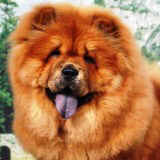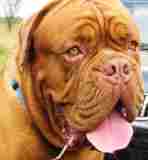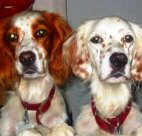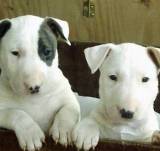|
The gentle, intelligent and family-friendly Labrador Retriever from
Canada continues to be the most popular breed in the United States.
This versatile hunting breed comes in three colors, yellow, black
and chocolate, and because of his aptitude to please his master
they excel as guide dogs for the blind, as part of search-and-rescue
teams or in narcotics detection with law enforcement. Labrador
Retrievers, originally from Newfoundland, were initially used in
work alongside fisherman, helping to pull in nets and catch fish
that escaped from fishing lines. After being crossed with Setters,
Spaniels and other Retrievers, the Labrador Retriever honed its
skills as a true retriever. From this point in the breed’s history,
"Labs," as they are affectionately called, were bred primarily to
perform as an efficient retriever of game, with a stable temperament
suitable for a variety of activities beyond hunting. The breed was
registered with the AKC in 1917.
General Appearance
There are two types of Labradors, the English Labrador and the
American Labrador. The English bred lab comes from English bred
stock. Their general appearance is different. The English bred labs
are heavier, thicker and blockier. The American bred Lab comes from
American bred stock and is tall and lanky. The Labrador Retriever is
a solid, muscular dog, slightly longer than tall, with a short,
hard, easy-care, water-resistant double coat that does not have any
waves and comes in solid black, yellow, or chocolate. There is also
said to be a rare silver or gray color that is referred to by the
AKC as a shade of chocolate. This color is controversial and some
claim it is a Weimeriner cross, while others say it is a true
mutation. The Labrador has a broad head, thick nose, scissors bite
and a pronounced stop. Its muzzle is fairly wide and its neck is
powerful. The eyes are chestnut or hazel with an intelligent
expression. The medium-sized ears are pendant. The otter tail is
strong, thick near the body then tapering, and completely covered
with hair. Its limbs have good bone structure. The webbed feet aid
in swimming.
Temperament
The most popular of all the AKC breeds, the Labrador Retriever is a
good natured, loving, and loyal dog that makes a wonderful family
pet. These dogs are intelligent, responsive, and obedient, which
makes them one of the easiest breeds to obedience train. The
Labrador Retriever is well suited to both inexperienced and
experienced dog owners. He is very quick to learn, and is friendly
and sociable, with a mild manner and a very amiable attitude. The
temperament and personality of the Labrador Retriever reflects his
number one position on the AKC popularity list. He is full of
energy, loves to join in with a wide range of activities, and has
plenty of love and affection to shower upon his family. The Labrador
Retriever is not a dog that is suited to those with little time for
their pets, as these dogs thrive on companionship and affection from
their loved ones. Some do have a tendency to chew, and in particular
can indulge in destructive chewing if neglected. Although these dogs
have plenty of spirit and some can be quite independent, they are
usually easy to train, as they are clever and eager to please. This
breed gets along with just about everyone, from children and
strangers to pets and other animals. These active dogs do require
regular exercise, and will fare well with a secure, safe area in
which to play and enjoy some exercise.
Grooming
The Labrador Retriever requires regular grooming with a firm bristle
brush. Special care should be given to the under coat to prevent
mats and tangles. Bathing or dry shampooing should only be done when
absolutely necessary.
Health Problems and Life Expectancy
The life expectancy of the Labrador Retriever is around 10-12 years.
Although generally healthy, Labrador Retrievers are still prone to
the same hip and joint problems that plague most large dogs
hip
dysplasia and elbow dysplasia. They are prone to a few eye disorders
as well Progressive Retinal Atrophy being the most serious. They
also have large appetites and a tendency toward obesity which needs
to be carefully checked by owners in order to keep the Lab generally
healthy.
Activity Level
Labrador Retrievers are very excitable and will require a great deal
of exercise, especially during the first three years of their lives.
At a bare minimum, you should expect to take your dog for about two
walks a day. Make sure to use a strong leash, as Labs have very
powerful neck and shoulder muscles and can easily pull you off
balance if you aren't careful. Labs are also natural and
enthusiastic swimmers. If you have access to any kind of
water--rivers, beaches, lakes, swimming pools, or even ponds--you
should make a point of using these as ideal exercise venues for your
Lab.
|












